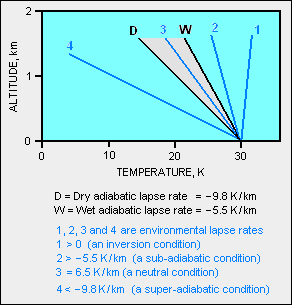User:Milton Beychok/Sandbox
Jump to navigation
Jump to search
The lapse rate (symbol ) refers to the change of an atmospheric variable with a change of altitude, the variable being temperature unless another variable is specified (such as pressure, density or humidity).[1] While usually applied to Earth's atmosphere, the concept of lapse rates can be extended to atmospheres (if any) that exist on other planets.
References
- ↑ The lapse rate is often defined as the negative change of temperature with a change of altitude. That definition is not used herein because it leads to statements such as "A positive lapse rate indicates temperatures cooling as height increases while a negative lapse rate indicates warming as height increases". That is counter-intuitive since lapse rates are usually expressed as a negative number (i.e., - 6.5 K/km) to indicate cooling with an increase of height.
Hold items
- Mark Zachary Jacobson (2005). Fundamentals of Atmospheric Modeling, 2nd. Cambridge University Press. ISBN 0-521-83970-X. </ref>
- C. Donald Ahrens (2006). Meteorology Today, 8th. Brooks/Cole Publishing. ISBN 0-495-01162-2. </ref>

